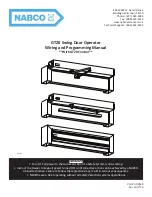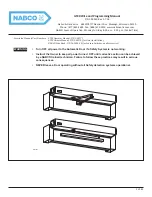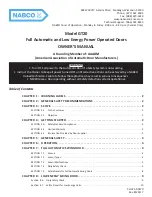
OM-530 Page 29
SECTION 8 – CERTIFICATION FOR HIGH FREQUENCY ARC WELDING EQUIPMENT
8-1. GENERAL
The following information is necessary to make a proper
installation of the high-frequency arc welding equipment
described in this instruction manual. In order to comply
with Part 18 of the Rules and Regulations of the Federal
Communications Commission (FCC), the certificate in
the front of this manual must be filled in completely and
signed after the unit has been correctly installed. The
certificate must be kept WITH THE EQUIPMENT AT
ALL TIMES to comply with the regulation. The manu-
facturer of the equipment covered herein has conducted
approved field tests and certifies that the radiation can
be expected to be within the legal limits if the correct in-
stallation procedures, as outlined, are followed. The im-
portance of a correct installation cannot be overempha-
sized since case histories of interference due to high-
frequency stabilized arc welding equipment have shown
that in most cases, an inadequate installation was at
fault. In the event that interference with authorized FCC
services occurs, the user is required to take suitable
steps to clear the situation. The Factory Service Depart-
ment personnel will assist the user by supplying techni-
cal information.
Instead of complying with the installation requirements
and the certification of each individual installation, the
user may elect to certify the entire plant by having a
qualified engineer make a plant radiation survey. In such
cases, these instructions could serve as a guide in mini-
mizing interference that might be caused by the high-
frequency arc welding equipment.
Many processes and applications of processes require
open-circuit voltages sufficient to jump from the elec-
trode to the work without making direct contact. The
maximum open-circuit voltage (OCV) of a welding
power source is not sufficient for this. In the Submerged
Arc Welding (SAW) process, granules of flux often get
between the electrode and the workpiece making start-
ing of the arc difficult at normal open-circuit voltages. A
higher voltage is also required to start and maintain a
stable arc in processes like the Gas Tungsten Arc Weld-
ing (GTAW) process. In these cases it will take several
thousand volts to cause an electrical spark to jump this
gap between the electrode and the work, creating an in-
itial path of ionization that the arc current can follow
without the hazards that would be present at power fre-
quency.
In order to provide these higher voltages, it is common
practice to superimpose a high open-circuit voltage on
the output of a welding power source by using high-fre-
quency techniques. The high-frequency voltage can be
a source of interference and will be discussed in this
section.
8-2. DEFINITIONS
A. High-Frequency Assisted Arc Welding Power
Sources
In the arc welding process, high frequency may be used
for initiating an arc or stabilizing the arc once it is struck,
or for both functions.
The energy from the high-frequency source must flow to
the welding electrode via a good quality, low impedance,
and well insulated connecting cable.
B. Welding Circuit
The welding circuit consists of all attachments con-
nected to the welding terminals.
C. Welding Terminals
Welding terminals are the terminals which provide weld-
ing power and high-frequency energy to the arc.
D. Electrode Terminal
The electrode terminal is the terminal to which the elec-
trode cable or welding torch is connected.
E. Welding Torch
A device used in the Gas Tungsten Arc Welding (GTAW)
process to control the position of the electrode, to trans-
fer current to the arc, and to direct the flow of shielding
gas.
F.
Work Terminal
The work terminal is the terminal to which the welding
workpiece is connected.
G. Welding Zone
The welding zone is the space within 50 ft. (15 m) in all
directions from the midpoint between the power source
and the welding arc (see Figure 8-6).
H. Bonding
Bonding refers to connecting metallic objects together
to cause the objects to be at the same potential regard-
less of any current flow between them (see Figure 8-3
and Figure 8-4).
I.
Grounding (Earthing)
Depending on the practices within jurisdictions, one of
these terms is commonly used to indicate the connec-
tion, or bonding, of parts of the apparatus to the
earth.The terms may be used interchangeably.
J.
Receiver
A receiver is any device normally used for receiving
electromagnetic energy and converting it to useful com-
munications purposes.
K. Conduction
Conduction is the transmission of high-frequency en-
ergy via an electrical conductor or conducting medium.
Содержание KC237900
Страница 20: ...OM 530 Page 16 ST 009 477 D ST 007 648 G...
Страница 31: ...OM 530 Page 27 Circuit Diagram No SC 080 063 E Diagram 7 4 Circuit Diagram For Electroslope Optional...
Страница 49: ...Notes...
















































